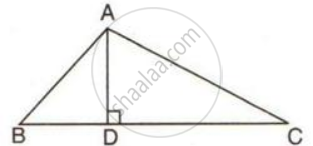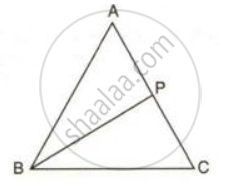Advertisements
Advertisements
Question
From the following figure; 
prove that:
(i) AB > BD
(ii) AC > CD
(iii) AB + AC > BC.
Solution
(i) ∠ADC + ∠ADB = 180° ...[ BDC is a straight line ]
∠ADC = 90° ...[ Given ]
90° + ∠ADB = 180°
∠ADB = 90° ....(i)
In ΔADB,
∠ADB = 90° ....[ From (i) ]
∴ ∠B + ∠BAD = 90°
Therefore, ∠B and ∠BAD are both acute, that is less than 90°.
∴ AB > BD ….(ii)[ Side opposite 90° angle is greater than the side opposite acute angle ]
(ii) In ΔADC,
∠ADB = 90°
∴ ∠C + ∠DAC = 90°
Therefore, ∠C and ∠DAC are both acute, which is less than 90°.
∴ AC > CD ...(iii)[ Side opposite 90° angle is greater than side opposite acute angle ]
Adding (ii) and (iii)
AB + AC > BD + CD
⇒ AB + AC > BC
APPEARS IN
RELATED QUESTIONS
The sides AB and AC of a triangle ABC are produced; and the bisectors of the external angles at B and C meet at P. Prove that if AB > AC, then PC > PB.
Prove that the straight line joining the vertex of an isosceles triangle to any point in the base is smaller than either of the equal sides of the triangle.
In the following figure, ABC is an equilateral triangle and P is any point in AC;
prove that: BP > PA
